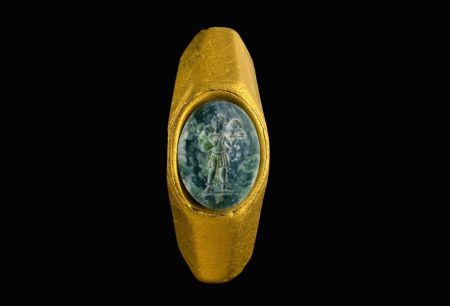Early Christian Good Shepherd ring discovered in 3rd century shipwreck off coast of Caesarea

Archeologists discovered hundreds of artifacts scattered underwater off the coast of Caesarea in Israel from two separate shipwrecks some 1,000 years apart.
One of the finds discovered by the Marine Archaeology Unit of the Israel Antiquities Authority was a gold ring featuring a green gemstone engraved with the figure of the Good Shepherd carrying a sheep or a ram on his shoulders, according to IAA.
In a Facebook post, the IAA said the image of The Good Shepherd "is one of the earliest and oldest images used in Christianity for symbolizing Jesus; it represents Jesus as humanity's compassionate shepherd, extending his benevolence to his flock of believers and all mankind."
The owner of the right was most likely an early Christian aboard a ship that sank it was heading into the port of Caesarea, the location of one of the earliest Christian communities.
"The ships were probably anchored nearby and were wrecked by a storm," IAA added. "They may have been anchored off shore after getting into difficulty, or fearing stormy weather because sailors know well that mooring in shallow, open water outside of a port is dangerous and prone to disaster."
Helena Sokolov, a curator at the IAA's coin department who researched the Good Shepherd ring, told Agence France-Press that the image of the Good Shepherd on a ring is a rare find.
"This was a period when Christianity was just in its beginning, but definitely growing and developing, especially in mixed cities like Caesarea," she told AFP, noting the ring’s small size might indicate that it belonged to a woman.
The other artifacts that were uncovered, which are believed to have been owned by people living in the Roman and Mamluk periods (1,700 to 600 years ago), consisted of hundreds of coins, silver and gold rings, rare gems, figurines, bells, the remains of the ships’ cargo and the remains of their wrecked hulls.
Among the items was a red gemstone for setting in a "gemma" ring, IAA added, with a carving that shows a lyre, which is called Kinor David or David's harp in Jewish tradition.
Other items discovered by the Marine Archaeology Unit of the IAA include:
- Hundreds of silver and bronze Roman coins from the mid-third century CE and a large hoard of silver coins from the Mamluk period (14th century; about 560 coins, including a large amount of smaller ribbon cut like pieces).
- A bronze figurine in the form of an eagle — symbolizing Roman rule.
- A figurine of a Roman pantomimus in a comic mask.
- Numerous bronze bells (used to ward off evil spirits).
- Pottery vessels
- An inkwell
- Multiple metal items from the hull of a wooden ship including: dozens of large bronze nails, lead pipes from a bilge pump, and a large iron anchor broken in pieces-attesting to the force it withstood until it finally snapped, probably in a storm.





















